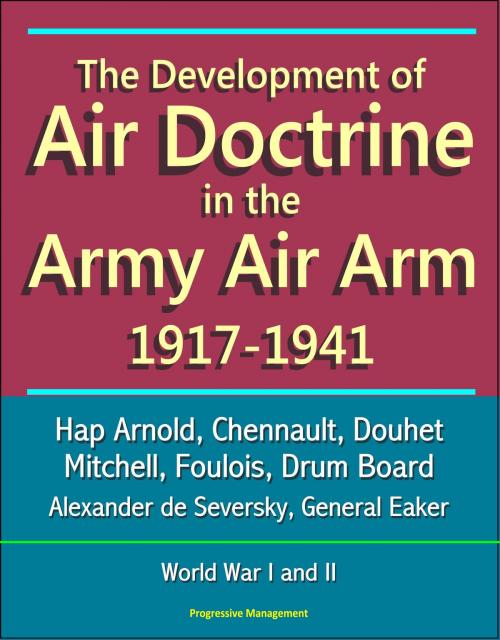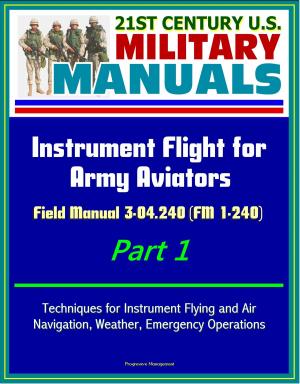The Development of Air Doctrine in the Army Air Arm 1917-1941: Hap Arnold, Chennault, Douhet, Mitchell, Foulois, Drum Board, Alexander de Seversky, General Eaker, World War I and II
Nonfiction, History, Military, Aviation| Author: | Progressive Management | ISBN: | 9781310289941 |
| Publisher: | Progressive Management | Publication: | May 9, 2014 |
| Imprint: | Smashwords Edition | Language: | English |
| Author: | Progressive Management |
| ISBN: | 9781310289941 |
| Publisher: | Progressive Management |
| Publication: | May 9, 2014 |
| Imprint: | Smashwords Edition |
| Language: | English |
This monograph recounts the development of air doctrine in the Army air arm from 1917 to 1941. It includes concepts, both strategic and tactical, that emerged during World War I and the period following, up to the entry of the United States into World War II. The study is based primarily on official Air Force records and upon interviews with officers of the air arm who have been especially associated with air doctrine.
When the debacle at Pearl Harbor thrust the United States into a war for survival, the nation marshalled its forces on land and sea and in the air. And although land, sea, and air forces all played vital roles in securing the triumph, the part of the air arm was unique. For the first time in the history of war, airpower was employed as a major striking force, drastically altering the course and nature of the struggle and decisively influencing the outcome.
CHAPTER 1 - THE AIR SERVICE IN WORLD WAR I, 1917-1918 * Prewar Organization and Concepts * American Participation in World War I * General concepts of warfare and air employment * Over-all air operations, organization, and control * Pursuit aviation Bombardment aviation * Attack aviation * Air plans during the armistice * CHAPTER 2 - THE HEROIC AGE OF DOCTRINAL DEVELOPMENT, 1919-1926 * Diverging Views of the Nature of War * The War Department view * Views of Air Service leaders * The Struggle for the Control of Airpower * Demands for complete separation * Arguments of the air crusaders * Rebuttal by the high command * Creation of the Army Air Corps (1926) * Evolving Doctrines of Air Employment * The general functions of military aviation * Argument with the Navy regarding coast defense * Pursuit aviation * Bombardment aviation * Attack aviation * Comparative summary of doctrines in 1926 * CHAPTER 3 - DEVELOPMENT OF THE AIR FORCE IDEA, 1926-1935 * Development of the High-speed Bomber * Efforts to stimulate improved aircraft design * Successful development of two-engine bombers: the B-9 and B-10 * The B-17 "Flying Fortress" * Trend of Doctrine at the Air Corps Tactical School * Concepts of the nature of war: influence of Mitchell and Douhet * The employment of airpower * Bombardment aviation; the precision doctrine and the escort problem * Pursuit aviation * Attack aviation * The Impasse with the Navy Regarding Land-based Bombardment * Establishment of the GHQ Air Force (1935) * CHAPTER 4 - REFINEMENT AND SUBSTANTIATION OF THE LONG-RANGE BOMBARDMENT CONCEPT, 1935-1939 * Hemisphere Defense Policy as a Factor in Strategic Concepts and Air Doctrine * Elaboration of Air Theory at the Air Corps Tactical School * The nature of war and the employment of airpower * Bombardment aviation * Pursuit aviation * Attack aviation * The Crucial Fight for Production and Development of the Long-range Bomber * Bomber program related to coast defense * Andrews presses for exclusive procurement of four-engine bombers * Air Corps demands for unlimited development of the bomber * The General Staff blocks the way * President Roosevelt removes the block * The Influence of Foreign Wars upon American Air Doctrine * China * Ethiopia * Spain * Munich * Adjustments in Air Organization * CHAPTER 5 - PREPARATION OF AIR DOCTRINE FOR WORLD WAR II, 1939-1941 * General Influence of the European War upon the Theory and Position of Airpower * Tactical Lessons from the Air War Abroad * Final Shaping of Air Doctrines on the Eve of American Involvement * Purpose and nature of warfare * The role and employment of airpower in war * Bombardment aviation * Pursuit aviation * Attack and light bombardment aviation * Blueprint for action: AWPD/1 * Establishment of Army Air Forces (1941) * CHAPTER 6 - CONCLUSIONS
This monograph recounts the development of air doctrine in the Army air arm from 1917 to 1941. It includes concepts, both strategic and tactical, that emerged during World War I and the period following, up to the entry of the United States into World War II. The study is based primarily on official Air Force records and upon interviews with officers of the air arm who have been especially associated with air doctrine.
When the debacle at Pearl Harbor thrust the United States into a war for survival, the nation marshalled its forces on land and sea and in the air. And although land, sea, and air forces all played vital roles in securing the triumph, the part of the air arm was unique. For the first time in the history of war, airpower was employed as a major striking force, drastically altering the course and nature of the struggle and decisively influencing the outcome.
CHAPTER 1 - THE AIR SERVICE IN WORLD WAR I, 1917-1918 * Prewar Organization and Concepts * American Participation in World War I * General concepts of warfare and air employment * Over-all air operations, organization, and control * Pursuit aviation Bombardment aviation * Attack aviation * Air plans during the armistice * CHAPTER 2 - THE HEROIC AGE OF DOCTRINAL DEVELOPMENT, 1919-1926 * Diverging Views of the Nature of War * The War Department view * Views of Air Service leaders * The Struggle for the Control of Airpower * Demands for complete separation * Arguments of the air crusaders * Rebuttal by the high command * Creation of the Army Air Corps (1926) * Evolving Doctrines of Air Employment * The general functions of military aviation * Argument with the Navy regarding coast defense * Pursuit aviation * Bombardment aviation * Attack aviation * Comparative summary of doctrines in 1926 * CHAPTER 3 - DEVELOPMENT OF THE AIR FORCE IDEA, 1926-1935 * Development of the High-speed Bomber * Efforts to stimulate improved aircraft design * Successful development of two-engine bombers: the B-9 and B-10 * The B-17 "Flying Fortress" * Trend of Doctrine at the Air Corps Tactical School * Concepts of the nature of war: influence of Mitchell and Douhet * The employment of airpower * Bombardment aviation; the precision doctrine and the escort problem * Pursuit aviation * Attack aviation * The Impasse with the Navy Regarding Land-based Bombardment * Establishment of the GHQ Air Force (1935) * CHAPTER 4 - REFINEMENT AND SUBSTANTIATION OF THE LONG-RANGE BOMBARDMENT CONCEPT, 1935-1939 * Hemisphere Defense Policy as a Factor in Strategic Concepts and Air Doctrine * Elaboration of Air Theory at the Air Corps Tactical School * The nature of war and the employment of airpower * Bombardment aviation * Pursuit aviation * Attack aviation * The Crucial Fight for Production and Development of the Long-range Bomber * Bomber program related to coast defense * Andrews presses for exclusive procurement of four-engine bombers * Air Corps demands for unlimited development of the bomber * The General Staff blocks the way * President Roosevelt removes the block * The Influence of Foreign Wars upon American Air Doctrine * China * Ethiopia * Spain * Munich * Adjustments in Air Organization * CHAPTER 5 - PREPARATION OF AIR DOCTRINE FOR WORLD WAR II, 1939-1941 * General Influence of the European War upon the Theory and Position of Airpower * Tactical Lessons from the Air War Abroad * Final Shaping of Air Doctrines on the Eve of American Involvement * Purpose and nature of warfare * The role and employment of airpower in war * Bombardment aviation * Pursuit aviation * Attack and light bombardment aviation * Blueprint for action: AWPD/1 * Establishment of Army Air Forces (1941) * CHAPTER 6 - CONCLUSIONS















